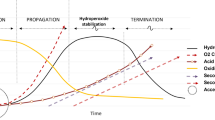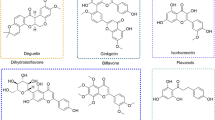Abstract
A new formulation of trans-resveratrol nanoparticles (t-RVT NPs) with potential stealth properties was prepared by nano-precipitation method in our laboratory. To investigate the pharmacokinetic of t-RVT NPs, a simple and rapid high performance liquid chromatographic method was developed for the quantification of trans-resveratrol in plasma of rats treated with t-RVT NPs. Catechin (0.2 μg/ml) was used as an internal standard (IS). The chromatographic separation was achieved on a reversed-phase C18 column using isocratic elution with methanol: 10 mM potassium dihydrogen phosphate buffer (pH 6.8): 3 % acetic acid solution (70:28:2, v/v/v) at a flow rate of 1 ml/min with a total run time of 6 min. The column effluent was monitored by UV detector at 306 nm. Calibration curve in plasma spiked with varying concentration of trans-resveratrol were linear over the concentration range of 0.010–3.2 μg/ml with correlation coefficient of (r2 > 0.9987). The system was found to construct sharp peaks for trans-resveratrol and IS with retention times of 3.82 and 5.49 min, respectively. The method was sensitive with a limit of quantification of 0.007 μg/ml. The method showing accuracy, precision (inter-day relative standard deviation (RSD) and intra-day RSD values <15.0 %. The method was applied for determining trans-resveratrol concentration in plasma after oral administration of 20 mg/kg of free trans-resveratrol and t-RVT NPs to rats. The plasma concentrations of trans-resveratrol and t-RVT NPs at 30 min and 10 h after oral administration were quantified as 0.1771 ± 0.38 and 5.64 ± 0.436 μg/ml. Results established selectivity and suitability of the method for pharmacokinetic studies of trans-resveratrol from t-RVT NPs.




Similar content being viewed by others
References
Amidon GL, Lennernäs H, Shah VP, Crison JR (1995) A theoretical basis for a biopharmaceutic drug classification: the correlation of in vitro drug product dissolution and in vivo bioavailability. Pharm Res 12:413–420
Amri A, Chaumeil JC, Sfar S, Charrueau C (2012) Administration of resveratrol: what formulation solutions to bioavailability limitations. J Control Release 158:182–193
Arichi H, Kimura Y, Okuda H, Baba K, Kozawa M, Arichi S (1982) Effects of stilbene components of the roots of. Polygonum cuspidatum Sieb. et Zucc. on lipid metabolism. Chem Pharm Bull 30:1766–1770
Baur JA, Sinclair DA (2006) Therapeutic potential of resveratrol: the in vivo evidence. Nat Rev Drug Discov 5:493–506
Bernardesa DC, Poppib RJ, Sena MM (2010) Direct determination of trans-resveratrol in human plasma by spectrofluorimetry and second-order standard addition. Talanta 82:640–645
Boocock DJ, Patel KR, Faust GES, Normolle DP, Marczylo TH, Crowell JA, Brenner DE, Booth TD, Gescher A, Steward WP (2007) Quantitation of trans-resveratrol and detection of its metabolites in human plasma and urine by high performance liquid chromatography. J Chromatogr B 848:182–187
Cantos E, Espin JC, Fernandez MJ, Oliva J, Tomas-Barberan FA (2003) Postharvest UV-C-irradiated grapes as a potential source for producing stilbene-enriched red wines. J Agric Food Chem 51:1208–1214
Chen X, He H, Wang G, Yang B, Ren W, Ma L, Yu Q (2007) Stereospecific determination of cis- and trans-resveratrol in rat plasma by HPLC: application to pharmacokinetic studies. Biomed Chromatogr 21:257–265
Das S, Ng KY (2011) Quantification of trans-resveratrol in rat plasma by a simple and sensitive high performance liquid chromatography method and its application in pre-clinical study. J Liq Chromatogr Relat Technol 34:1399–1414
Delmas D, Lancon A, Colin D, Jannin B, Latruffe N (2006) Resveratrol as a chemopreventive agent: a promising molecule for fighting cancer. Curr Drug Targets 7:423–442
Gao J, Zhong D, Duan X, Chen X (2007) Liquid chromatography/negative ion electrospray tandem mass spectrometry method for the quantification of rosuvastatin in human plasma: application to a pharmacokinetic study. J Chromatogr B Analyt Technol Biomed Life Sci 856:35–40
He H, Chen X, Wang G, Wang J, Davey AK (2006) High-performance liquid chromatography spectrometric analysis of trans-resveratrol in rat plasma. J Chromat B 832:177–180
Juan ME, Lamuela-Raventos RM, Torre-Boronat DL, Planas JM (1999) Determination of trans-resveratrol in Plasma by HPLC. Anal Chem 71:747–750
Juan ME, Maijo M, Planas JM (2010) Quantification of trans-resveratrol and its metabolites in rat plasma and tissues by HPLC. J Pharm Biomed Anal 51:391–398
Kakkara V, Singh S, Singla D, Sahwney S, Chauhan AS, Singh G, Kaur IP (2010) Pharmacokinetic applicability of a validated liquid chromatography tandem mass spectroscopy method for orally administered curcumin loaded solid lipid nanoparticles to rats. J Chromat B 878:3427–3431
Kim S, Kiong NGW, Dong Y, Das S, Tan RBH (2012) Preparation and physicochemical characterization of trans-resveratrol nanoparticles by temperature-controlled antisolvent precipitation. J Food Eng 108:37–42
Kristl J, Teskac K, Caddeo C, Abramovic Z, Sentjurc M (2009) Improvement of cellular stress response on resveratrol in liposomes. Eur J Pharm Biopharm 73:253–259
Langcake P, Pryce RJ (1976) The production of resveratrol by Vitis vinifera and other members of the Vitaceae as a response to infection or injury. Physiol Plant Pathol 9:77–86
Lopez NJM, Nunez DE, Perez LAJ, Barrachina AC, Cuadra CP (2006) Determination of stoichiometric coefficients and apparent formation constants for β-cyclodextrin complexes of trans-resveratrol using reversed-phase liquid chromatography. J Chromatogr A 1135:158–165
Martins SM, Wendling T, Goncalves VMF, Sarmento B, Ferreira DC (2012) Development and validation of a simple reversed-phase HPLC method for the determination of camptothecin in animal organs following administration in solid lipid nanoparticles. J Chromat B 880:100–107
Mittal G, Sahana DK, Bhardwaj V, Kumar MNVR (2007) Estradiol loaded PLGA nanoparticles for oral administration: effect of polymer molecular weight and copolymer composition on release behavior in vitro and in vivo. J Control Release 119:77–85
Ortuno J, Covas MI, Farre M, Pujadas M, Fito M, Khymenets O, Lacueva CA, Roset P, Joglar J, Lamuela-Raventos RM, Torre RDL (2010) Matrix effects on the bioavailability of resveratrol in humans. Food Chem 120:1123–1130
Singh G, Pai RS, Pandit V (2012) Development and validation of a HPLC method for the determination of trans-resveratrol in spiked human plasma. J Adv Pharm Tech Res 3:130–135
The United States Pharmacopoeia, (2008) USP31-NF26, 1225 752
Touzet O, Philips A (2010) Resveratrol protects against protease inhibitor-induced reactive oxygen species production, reticulum stress and lipid raft perturbation. AIDS 24:1437–1447
US DHHS, FDA, CDER. Guidance for Industry: Bioanalytical Method Validation. US Department of Health and Human Services, Food and Drug Administration, Center for Drug Evaluation and Research, Center for Veterinary Medicine, 2001. www.fda.gov/cder/guidance/index.htm. Accessed 11 Feb 2013
Vian MA, Tomao V, Gallet S, Coulomb PO, Lacombe JM (2005) Simple and rapid method for cis- and trans-resveratrol and piceid isomers determination in wine by high-performance liquid chromatography using Chromolith columns. J Chromatogr A 1085:224–229
Acknowledgments
This article does not contain any studies with human and animal subjects performed by any of the authors. All authors (G. Singh, R.S. Pai, V. Pandit) declare that they have no conflict of interest. The authors gratefully acknowledge financial support and granting research fellowship (45/38/2011/Nan-BMS) from ICMR (Indian Council of Medical Research, Govt of India, New Delhi). Authors are also grateful to Sami Labs, Bangalore, India for providing the gift samples of trans-resveratrol and catechin.
Author information
Authors and Affiliations
Corresponding author
Rights and permissions
About this article
Cite this article
Singh, G., Pai, R.S. & Pandit, V. In vivo pharmacokinetic applicability of a simple and validated HPLC method for orally administered trans-resveratrol loaded polymeric nanoparticles to rats. Journal of Pharmaceutical Investigation 44, 69–78 (2014). https://doi.org/10.1007/s40005-013-0105-0
Received:
Accepted:
Published:
Issue Date:
DOI: https://doi.org/10.1007/s40005-013-0105-0




